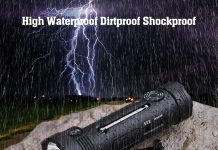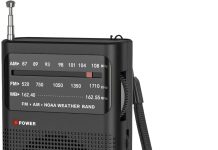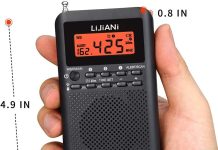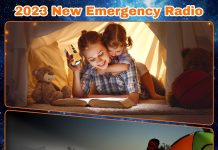In this article, we explore whether emergency radios have the capability to tune into aviation and marine weather bands. Many of us rely on emergency radios to keep us informed and prepared during times of crisis, but can they also provide us with crucial weather updates for aviation and marine activities? Join us as we uncover the possibilities of emergency radios and their potential to serve as a reliable source of weather information for pilots, sailors, and outdoor enthusiasts alike.
Review contents
What are emergency radios?
Definition of emergency radios
Emergency radios, also known as weather radios, are portable communication devices specifically designed to receive and broadcast important weather information during emergencies. These radios are equipped with specialized features that allow users to tune into specific frequency bands, such as aviation and marine weather bands, to stay updated on crucial weather conditions.
Features of emergency radios
Emergency radios typically come with a variety of features to enhance their functionality and usability. Some common features include:
-
Weather band reception: Emergency radios are equipped with built-in receivers that can tune into specific frequency bands used for weather broadcasts.
-
Alert systems: These radios have emergency alert systems that automatically activate and alert users when there are severe weather warnings or other emergency notifications issued by authorities.
-
Battery-powered: Emergency radios are portable and often operate on batteries, making them reliable even during power outages or when there is no access to mains electricity.
-
Antenna: An extendable antenna or a built-in telescopic antenna helps improve signal reception, ensuring a clear and uninterrupted transmission of weather information.
-
Multiple power options: Many emergency radios have alternative power options, including solar panels, hand-crank generators, and the ability to charge via USB, making them suitable for use in remote areas or when traditional power sources are not available.
-
LED flashlight: Some emergency radios also feature an integrated LED flashlight, which can be invaluable during power outages or in low-light situations.
Importance of emergency radios in emergencies
Emergency radios play a crucial role in ensuring the safety and well-being of individuals during emergencies. Here are a few reasons why they are important:
-
Timely weather updates: Emergency radios allow users to receive real-time weather updates, including severe weather warnings, watches, and advisories. These updates enhance situational awareness and help individuals make informed decisions to protect themselves and their property.
-
Reliable communication: During emergencies, traditional communication channels can become unreliable or overloaded. Emergency radios provide a reliable means of communication and information dissemination, allowing individuals to stay connected with rescue services, authorities, and other important channels.
-
Preparedness and proactive planning: By having access to accurate and up-to-date weather information, individuals can proactively plan and prepare for impending adverse weather conditions. This includes taking appropriate precautions, evacuating if necessary, and ensuring the safety of their loved ones.
-
Specific information for different user groups: Emergency radios are designed to cater to the specific needs of different user groups, such as aviators and mariners. They provide specialized weather information relevant to these user groups, allowing them to make informed decisions based on their unique requirements and circumstances.
-
Community safety: The use of emergency radios promotes community safety by enabling individuals to share information about hazardous conditions, coordinate rescue and relief efforts, and provide updates to neighbors and local authorities.
In summary, emergency radios are essential tools for receiving timely weather updates, ensuring reliable communication during emergencies, facilitating proactive planning, catering to specific user groups, and promoting community safety.
Understanding aviation weather bands
Overview of aviation weather bands
Aviation weather bands are specific radio frequency ranges allocated for the transmission and reception of weather-related information pertinent to aviation. These bands are used to provide pilots with critical weather updates, forecasts, and other essential data required for safe flight operations.
Frequency range of aviation weather bands
Aviation weather bands typically operate within the Very High Frequency (VHF) range. The specific range designated for aviation weather information varies from region to region, but in most countries, it falls between 118 and 137 MHz.
Primary users of aviation weather bands
The primary users of aviation weather bands are aviators, including pilots, air traffic controllers, and aviation weather forecasters. Pilots rely on these specific frequency bands to receive accurate weather reports, including conditions such as thunderstorms, turbulence, icing, and strong winds, which can greatly impact flight safety.
Tuning into aviation weather bands with emergency radios
Compatibility of emergency radios with aviation weather bands
Many emergency radios are designed to be compatible with aviation weather bands, allowing users to tune into these frequencies and receive aviation-specific weather information. Compatibility is typically indicated through specific frequency range settings or dedicated aviation weather band channels on the radio.
Capabilities of emergency radios for aviation weather bands
Emergency radios equipped with aviation weather band capabilities offer a range of features tailored to the needs of aviators. These can include dedicated channel presets, programmable memory banks for quick access to specific frequencies, and the ability to scan through aviation weather bands to find the strongest and clearest signals.
Benefits of using emergency radios for aviation weather bands
Utilizing emergency radios for accessing aviation weather bands provides several benefits to aviators, including:
-
Safety enhancement: By receiving accurate and timely weather updates specific to aviation, pilots can make informed decisions that prioritize safety. They can avoid hazardous weather conditions, plan alternate routes, or choose to delay or divert flights when necessary.
-
Backup communication: In situations where cockpit communication systems may be compromised or unavailable, emergency radios can serve as a reliable backup communication tool for pilots to stay in touch with air traffic control or receive important weather updates.
-
Portability and accessibility: Emergency radios are portable, allowing pilots to carry them onboard aircraft or have them readily available in flight bags. This ensures easy access to critical weather information regardless of the location or operational circumstances.
-
Cost-effectiveness: Dedicated aviation band receivers can be expensive and may require additional installations or certifications. Emergency radios that offer aviation weather band tuning capabilities provide a more cost-effective alternative for pilots to access the necessary weather information.
Overall, using emergency radios for aviation weather bands offers safety enhancements, backup communication options, portability, accessibility, and cost-effectiveness for aviators.
Exploring marine weather bands
Overview of marine weather bands
Marine weather bands are specific frequency ranges used to transmit weather-related information for mariners, boaters, and other maritime users. These bands provide critical weather updates, forecasts, and navigational warnings to improve safety and ensure a smooth and informed sailing experience.
Frequency range of marine weather bands
Marine weather bands primarily operate within the Very High Frequency (VHF) range, similar to aviation weather bands. The frequency range for marine weather bands varies depending on the country or region, but it commonly falls between 156 and 162 MHz.
Importance of marine weather bands for boaters and sailors
Marine weather bands are of paramount importance for boaters and sailors due to the following reasons:
-
Safety at sea: Access to accurate and up-to-date weather information allows boaters and sailors to anticipate and navigate hazardous weather conditions effectively. Marine weather bands provide essential data on storms, fog, wind patterns, tides, and other factors that can significantly impact safety while at sea.
-
Navigation and route planning: Mariners rely on marine weather band transmissions to stay informed about navigational hazards, such as submerged objects, shallow waters, and restricted areas. This information aids in route planning and ensures vessels can avoid potential dangers.
-
Communication and coordination: Marine weather bands facilitate communication and coordination among mariners by enabling the exchange of important weather-related updates, safety advisories, and emergency notifications within the maritime community.
-
Compliance with regulations: Many maritime authorities mandate the use of marine weather bands to ensure vessels have access to weather updates, contributing to the overall safety and well-being of boaters and sailors. Adhering to these regulations is essential to avoid penalties and potentially dangerous situations.
In summary, marine weather bands provide crucial weather information for boaters and sailors, enhancing safety at sea, aiding in navigation and route planning, facilitating communication and coordination, and ensuring compliance with regulations.
Using emergency radios to access marine weather bands
Ability of emergency radios to tune into marine weather bands
Emergency radios designed for weather reception often include marine weather band tuning capabilities, allowing users to access the specific frequencies used to transmit marine weather information. These radios typically have settings or dedicated channels specifically programmed for marine band reception.
Features of emergency radios for marine weather bands
Emergency radios equipped with marine weather band features offer a range of functionalities to cater to the needs of boaters and sailors. Some common features include:
-
Channel presets: These radios often have pre-programmed channels for quick access to commonly used marine weather frequencies, making it easier for users to switch between different channels and stay updated on various weather conditions.
-
Weather alerts: Similar to the emergency alert systems for other weather bands, marine weather band-compatible emergency radios can also automatically receive and alert users to important weather advisories and warnings issued by maritime authorities.
-
Dual watch capability: Some advanced emergency radios offer a dual watch feature that allows users to monitor two separate marine frequencies simultaneously. This feature is especially useful when needing to listen to multiple marine channels or when waiting for important weather updates.
-
Water-resistant design: Considering the marine environment, emergency radios designed for boat and sail use often feature water-resistant or waterproof designs. This ensures their durability and longevity in damp or wet conditions.
Advantages of using emergency radios for marine weather bands
Utilizing emergency radios for accessing marine weather bands offers several benefits to boaters and sailors, including:
-
Safety enhancement: By staying connected to marine weather bands, boaters and sailors can receive timely weather updates, warnings, and navigational information. This enables them to make informed decisions to ensure their safety and the safety of their vessel and crew.
-
Convenience and portability: Emergency radios are portable and suitable for use onboard boats or carried in marine emergency kits. They provide boaters and sailors with a convenient and accessible means of receiving marine weather information, regardless of their location.
-
Cost-effective solution: Dedicated marine band receivers can be costly, and their installation may require professional assistance. Emergency radios that offer marine weather band capabilities provide a cost-effective alternative, allowing individuals to access vital weather information without significant expenses.
-
Emergency communication: In emergency situations, when traditional communication methods may be unreliable or unavailable, emergency radios can serve as a crucial communication tool. They allow boaters and sailors to transmit emergency signals, request assistance, and receive important updates from other maritime users or authorities.
In conclusion, using emergency radios to access marine weather bands enhances safety, provides convenience and portability, offers a cost-effective solution, and facilitates emergency communication for boaters and sailors.
Choosing the right emergency radio for aviation and marine weather
Factors to consider when selecting an emergency radio
When choosing an emergency radio with aviation and marine weather band tuning capabilities, several factors should be taken into account:
-
Compatibility and frequency coverage: Ensure the emergency radio is compatible with the specific aviation and marine frequency bands relevant to your region. Check that the radio covers the necessary frequency range to receive the required weather information.
-
Ease of use: Look for an emergency radio that is user-friendly and intuitive to operate. Consider features such as a clear and easy-to-read display, straightforward buttons or controls, and an ergonomic design that suits your preferences.
-
Power options and battery life: Determine the power options available for the emergency radio, including battery types, alternative power sources, and estimated battery life. Consider how long the radio can operate on a single charge or set of batteries to ensure it meets your expected usage requirements.
-
Durability and water resistance: Given the environments in which emergency radios may be used (e.g., on boats or in outdoor settings), it is essential to choose a radio that is durable and water-resistant. Look for models with appropriate certifications or IPX ratings indicating their resistance to water and dust.
-
Additional features: Consider any additional features that may be useful for your specific needs. These can include built-in flashlights, USB charging ports, auxiliary audio input/output, or the ability to receive AM/FM radio frequencies.
Specific features for aviation weather band tuning
When selecting an emergency radio for aviation weather band tuning, consider the following specific features:
-
Aviation presets: Look for an emergency radio that provides dedicated presets or memory storage for aviation frequency channels. This allows for quick and easy access to commonly used aviation weather frequencies.
-
Scan functions: Ensure the radio has the capability to scan through aviation weather bands for the strongest signal reception. This feature helps identify the clearest weather broadcasts in your location.
-
Backlit display: Opt for a radio with a backlit display to ensure visibility and legibility, especially in low-light or cockpit conditions.
Specific features for marine weather band tuning
When choosing an emergency radio for marine weather band tuning, consider the following specific features:
-
Channel availability: Look for a radio that includes pre-programmed marine weather channels and allows for the addition of custom channels. Ensure the radio covers the necessary frequency range for marine weather bands relevant to your area.
-
Weather alerts: Verify that the radio has the functionality to receive and automatically alert you to important marine weather advisories and warnings.
-
Weather channel scanning: Choose a radio with the capability to scan through marine weather channels, making it easier to find and monitor the desired weather frequency.
-
Noise-canceling capabilities: Opt for a radio equipped with noise-canceling features or filters to minimize interference from background noise, such as engine sounds or wind, for clearer weather broadcasts.
Alternative options for accessing aviation and marine weather bands
Dedicated aviation band receivers
For individuals who require more specialized and comprehensive access to aviation weather information, dedicated aviation band receivers are available. These receivers are specifically designed for aviators and often offer advanced features tailored to aviation needs.
Dedicated aviation band receivers may provide additional functionalities such as complete frequency coverage, extensive memory banks for storing flight plans, extended battery life, and compatibility with aviation databases for navigation purposes. However, they tend to be more expensive and may require professional installations or certifications.
Dedicated marine band receivers
Similar to dedicated aviation band receivers, dedicated marine band receivers provide comprehensive coverage and advanced functionalities for boaters and sailors. These receivers are specifically designed for marine use and often feature additional maritime-related features, such as navigational assistance, vessel tracking, and vessel-to-vessel communication capabilities.
Dedicated marine band receivers may offer extended range coverage, superior weatherproofing, larger displays, optimized marine channel scanning, and integration with navigation systems. However, like dedicated aviation band receivers, they can be more costly and require professional installations or certifications.
Combination devices for both aviation and marine bands
For those who require access to both aviation and marine weather bands, combination devices that incorporate tuners for both bands are available. These devices provide the convenience of accessing both sets of frequencies in a single portable unit.
Combination devices often offer similar features to dedicated receivers, such as channel presets, scanning functionalities, alert systems, and additional resources for aviation or marine navigation. They can be a cost-effective solution for individuals who require access to both aviation and marine weather information.
Regulations and licensing for aviation and marine weather band tuning
Legal requirements for accessing aviation weather bands
Accessing and utilizing aviation weather bands may be subject to certain legal requirements and restrictions. Regulations vary by country or region, and it is essential to comply with local laws when tuning into aviation frequencies.
In some jurisdictions, a valid pilot’s license or special authorization may be required to access and operate radios capable of tuning into aviation weather bands. Additionally, there may be restrictions on the use of certain frequencies or transmitting communications, which are reserved for air traffic control or other authorized entities.
It is crucial to understand and adhere to the legal requirements applicable to aviation weather band tuning in your respective area to avoid any legal implications or safety concerns.
Licensing and certifications for marine weather band tuning
The licensing and certifications required for marine weather band tuning generally depend on the country or region of operation. In some areas, no specific license or certification may be needed to access marine weather bands.
However, certain countries require operators of marine radios to obtain a Restricted Operator’s Certificate (ROC) or other form of maritime radio operator certification. These licenses aim to ensure that individuals using marine radios are knowledgeable about proper usage, radio procedures, and safety protocols.
It is advisable to familiarize yourself with the licensing and certification requirements applicable to marine weather band tuning in your region and obtain the necessary credentials to ensure legal compliance.
Restrictions and limitations for emergency radios
Despite the accessibility and convenience offered by emergency radios for accessing aviation and marine weather bands, there may be certain restrictions and limitations on their usage:
-
Range limitations: Emergency radios, especially handheld models, may have limited transmission and reception ranges. Users should be aware of the radios’ effective ranges, keeping in mind that distance, terrain, and environmental factors can impact signal strength and clarity.
-
Interference issues: Emergency radios are susceptible to interference from various sources, including other nearby electronic devices, weather conditions, or natural obstacles. Users should be mindful of potential interference and choose frequencies or channels with the least amount of interference.
-
Legal limitations: As previously mentioned, there may be legal restrictions on accessing certain frequency ranges or transmitting communications on specific frequencies. Users must ensure compliance with local regulations governing radio usage, licensing requirements, and restricted frequencies.
-
Reliance on external infrastructure: In some cases, emergency radios may rely on external infrastructure, such as broadcasting stations or communication networks, for optimal operation. During emergencies or in remote areas, this infrastructure may be compromised, limiting the effectiveness or availability of emergency radio signals.
Overall, while emergency radios offer valuable capabilities for accessing aviation and marine weather bands, users should be aware of the limitations and restrictions associated with their usage to ensure optimal performance and legal compliance.
Best practices for using emergency radios for aviation and marine weather
Staying updated with weather forecasts
To make the most effective use of emergency radios for aviation and marine weather, it is crucial to stay updated with weather forecasts. Here are some best practices for staying informed:
-
Regularly monitor weather broadcasts: Set aside dedicated times to listen to weather broadcasts on the appropriate frequency bands. Establish a routine to stay updated on any relevant weather changes or warnings.
-
Use multiple information sources: Emergency radios are valuable tools, but they should not be the sole source of weather information. Use other sources, such as local meteorological websites, mobile weather apps, or television weather reports, to gather a comprehensive understanding of the weather conditions.
-
Verify forecasts with multiple sources: Weather forecasts can occasionally vary between sources. Cross-reference information from different meteorological services or organizations to ensure the accuracy of the weather reports you receive.
Learning how to interpret aviation and marine weather reports
Interpreting aviation and marine weather reports is essential to making informed decisions. Consider these best practices:
-
Educate yourself on weather terminology: Familiarize yourself with the technical vocabulary commonly used in aviation and marine weather reports. Understand terms related to cloud types, visibility, air pressure, wind speed, and other weather phenomena specific to your field of interest.
-
Seek guidance from experts: If you are new to aviation or marine activities, consult experienced pilots, sailors, or weather forecasters to gain insights into interpreting weather reports effectively. They can provide guidance and practical advice based on their expertise and experiences in these domains.
-
Attend weather-related training courses: Consider enrolling in courses or workshops that provide in-depth knowledge and training on navigating aviation or marine weather conditions. These courses can enhance your understanding of critical weather factors and help you interpret reports accurately.
Emergency communication protocols and guidelines
During emergencies, effective communication is crucial. Consider these best practices for emergency communication:
-
Establish a communication plan: Develop a communication plan or protocol for your group or organization, clearly defining roles, responsibilities, and channels of communication during emergencies. Ensure that everyone involved understands the plan and their assigned roles.
-
Maintain a list of emergency contact information: Keep a list of essential emergency contact numbers, including those for air traffic control, coast guard stations, the nearest weather office, or any other key authorities. Have this information readily accessible.
-
Regularly practice emergency procedures: Conduct periodic drills or exercises to practice emergency communication procedures. This helps ensure that everyone is familiar with the protocols and can effectively execute them when needed.
Conclusion
In conclusion, emergency radios play a vital role in accessing aviation and marine weather bands, providing users with critical weather information during emergencies. These radios offer compatibility with specific frequency ranges, such as aviation weather bands and marine weather bands, enabling aviators, boaters, and sailors to stay informed in their respective domains.
Aviation and marine weather band tuning with emergency radios enhance safety by providing timely weather updates, backup communication options, portability, accessibility, and cost-effective solutions. They allow users to prioritize safety, make informed decisions, and coordinate emergency efforts during adverse weather conditions.
When selecting an emergency radio, consider factors such as compatibility, ease of use, power options, durability, and specific features for aviation and marine band tuning. Alternative options, including dedicated band receivers and combination devices, cater to different user needs and preferences.
It is essential to be aware of legal requirements, licensing, and certifications associated with accessing aviation and marine weather bands. Familiarize yourself with regulations governing frequency usage and comply with licensing and certification obligations to ensure legal compliance.
To optimize the use of emergency radios for aviation and marine weather bands, adopt best practices such as staying regularly updated with weather forecasts, learning how to interpret weather reports, and following established emergency communication protocols and guidelines.
By utilizing emergency radios and following the recommended practices, users can harness the capabilities and benefits of these devices, ensuring their safety and facilitating effective communication and decision-making in aviation and marine environments.



























